- Offensive Techniques & Strategies
Basketball Offenses
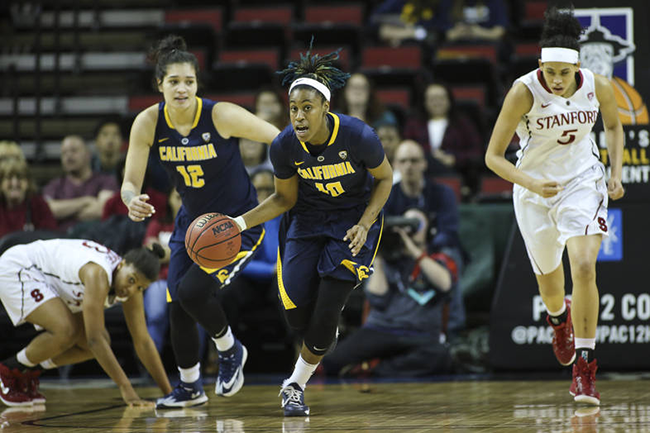
The various types of offenses are designed to use teamwork to free up or isolate players for good shots against a multitude of defenses. Offenses must be simple with the emphasis on execution and fundamentals. Offensive spacing should provide for strong offensive rebounding position as well as allowing for defensive balance. Offenses must be flexible to meet various types of defensive pressure. They must also have counter options that take advantage of any defensive overplays and traps. Offenses can be categorized into Early, Set, Motion, Zone, and Spread.
| Types of Offenses | Basic Offensive Alignments | Offensive Things to Remember |
Early Offenses
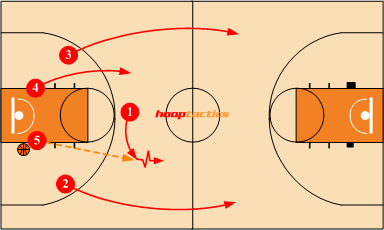
Most early offenses depend on quick, wide lane releases, inbound passes, and pass advances to reach the offensive operating areas before all of the defenders can retreat into the front court area. By advancing the ball into the offensive operating area within 2 to 3 seconds, the defenders are most often spread out, creating an opportunity for a high percentage of field goal attempts. Getting into offense before the defense can establish proper player match-ups also creates severe mismatches. When the early push does not create a good shot or advantage it is important to move right into an offensive flow without allowing the defense to set up.
Set Offenses
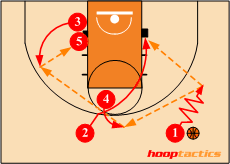
Though most teams would prefer to play the up-tempo, fast-break transition game that personifies today's basketball, the "Set Play" is the staple of the game. Set plays use teamwork and screening actions in an effort to create good shots. The type of set plays used are predicated upon the team's player personnel. On the court, set plays are initiated by a verbal or visual hand signal.
Motion Offenses
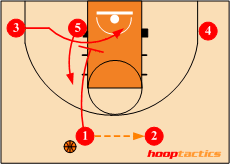
Through constant player movement, teams of average size and abilities can overcome and defeat teams of superior talent and size. However, this requires players to play together as a single unit. More importantly, it requires players to possess an unselfish attitude to create open shot opportunities for their teammates. This constant player movement must have purpose and patience in attacking the defense. Since all offensive movement is based on defensive reads rather than set action, it is difficult for opponents to scout and defend.
Zone Offenses
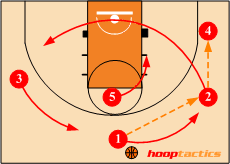
The need for a solid zone attack is paramount on every level of the game. Attacking zone defenses requires ball movement and total team effort compared to the player movement and individual skills required in attacking man-to-man defenses. Before undertaking any specific zone offense, coaches and players must have a working knowledge of the strengths and weaknesses of the various zone defenses. They also need to know how to exploit poor zone defenders. Good outside shooting, early offense (fast breaks) and offensive rebounding are key elements to a successful zone offense.
Spread Offenses
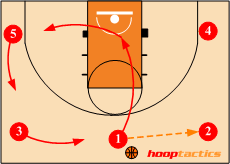
Spread offenses are normally deployed at the end of game to protect a hard earned lead, or when a team is totally mismatched. By spreading the court, it not only takes time off the clock, but also increases the area the defense must defend. However, in spreading the court, teams must make sure to continue to make basket cuts and attack the basket. Holding the ball for the sake of trying to run time off the clock will allow the defense to become more aggressive and disruptive.
Basic Offensive Alignments
There are 12 commonly used offensive alignments. These different alignments are designed to take advantage of the strengths of a team's specific player personnel. A good offensive strategist not only knows the advantages and disadvantages of each alignment, but more importantly when to employ them. This may vary from game to game or even year to year.
Single Post, Four Out
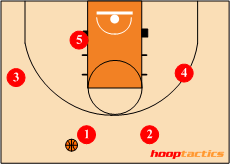
Single Post or Four Out alignment is a favorite to use when a team has an exceptionally, good post up player since it isolates the post One-on-One near the basket.
Single Stack
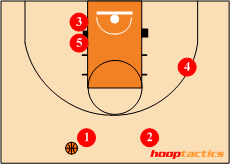
The Single Stack alignment is used against pressure defense. Once the entry pass is successfully made, it isolates the post One-on-One.
Double Stack
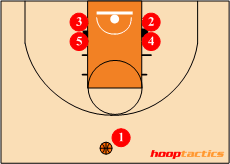
In the Double Stack alignment two posts are used to free up shooters.
Double Post, Three Out
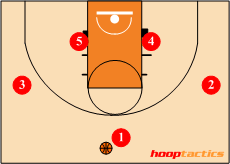
The Double Post or Three Out is used when a team has two good post players ("Twin Towers").
High Post, Two-Three High
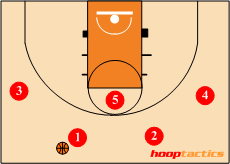
The High Post alignment is used when teams do not have a big post player or when the post player is a good outside shooter. It opens up the baseline for cuts and dribble penetrations.
Open, Spread, Donut
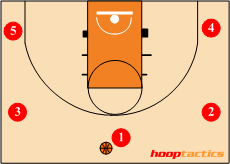
The Open or Spread is sometimes called "Donut." This no post alignment spreads the floor for cuts and dribble penetrations. Commonly used by teams without post players or at the end of the game to protect a lead.
One Four High
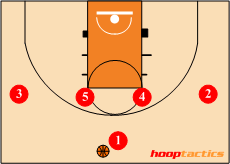
Four High is an excellent alignment to use against pressure defense since the point guard has four direct entry pass options.
One Four Low or Flat
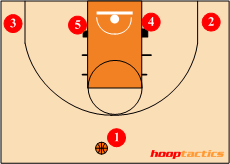
One Four Low or Flat is used to isolate a ballhandler One-on-One. It is commonly used at the end of a period or game.
Mid Screen
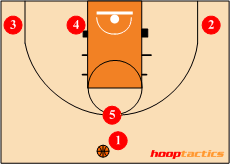
The Mid screen alignment isolates a post player ("big")with a ballhandler ("small") in the center of the court for screen and roll action with spot up shooters in the corners.
Horns
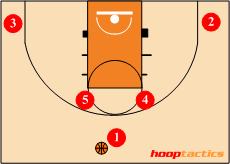
The Horns or "V" alignment is used to create screen and roll action. In this double high post alignment the point guard can initiate the screen and roll action in either direction.
One-Three-One
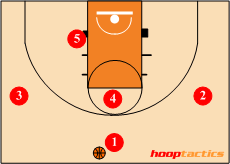
The One-Three-One is a popular alignment to use against zone defenses. It is also used to isolate the low post in high/low post feed action.
Overload
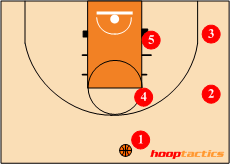
Overload places all five offensive players on one side of the court. This alignment is used primarily against zone defenses.

Things to Consider About Offense
1. Winning basketball is a team effort with all five teammates receiving help from one another.
2. Offensive fundamentals must be mastered before any offense can be run. A play, no matter how good, will never be successful unless it is executed properly.
3. Move the ball with sharp, accurate passing. Pass to the open man. You will be surprised how many times that’s you.
4. Get open for shots before you receive the ball. Work for the ball, do not stand and call for it.
5. Meet all passes assuming a triple threat stance (shot, drive, & pass) upon receiving it.
6. When over-played by a defender, back cut to the basket and shoot over any defender that sags off.
7. Avoid the trap or one bounce dribble. Always stop your dribble with a shot or pass.
8. Never dribble when it is possible to pass. Too much dribbling ruins team play.
9. Develop pride in your passing and work hard to perfect all types of passes.
10. Take good shots. Make sure no teammate is open for a better shot.
11. Assume every shot will be missed and rebound. Getting second and third efforts are imperative.
12. Without the ball, move with a purpose. Each movement should result in a screen, pass reception, rebounding position, or a good shot.
13. Free throw shooting is a repetitive, neuromuscular skill, the more you practice, the more accurate you will become.
14. Use the change of pace and direction effectively to get open. Make sharp cuts and avoid moving in arcs.
15. Acknowledge and compliment every assist, save, clutch rebound or other valuable play by a teammate.
16. Back cut to the basket or clear out when a teammate dribbles towards you.
17. Posting up is not limited to just big players, look for all teams to exploit size mismatches at any position. On mismatches is much better to take your defender inside than to go one on one outside.
18. It is better to be a second late than a second early on offense.
19. Always know how much time and how many time outs are left in a game.
20. Bill Russell, one of the most dominant players ever to play the game, is a reminder how great you can become without being a high scorer.
Next, take a look at the various types of defenses - Click Here
Return to Basketball Basics' Main Menu - Click Here
© 2026 HoopTactics All Rights Reserved.
